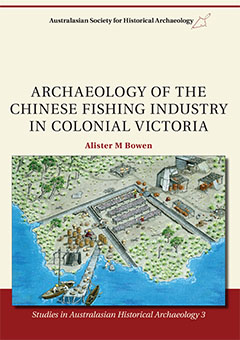
Archaeology of the Chinese Fishing Industry in Colonial Victoria, Alister Bowen, 2013
Studies in Australasian Historical Archaeology 3
During the 1850s and 1860s, Chinese immigrants played a major role in the development of the fishing industries in Australia. Prior to their involvement, the industry was hampered by the problems posed by the transportation of fish to market. It was common for whole catches of fish to putrefy before they could reach their destination. The influx of Chinese gold miners, who relied on fish as a dietary staple, increased the demand that prompted the creation of many Chinese fish-curing establishments.
Chinese fish curers in colonial Australia fished but also purchased large quantities of fish, creating a new and reliable market for European fishermen. Fish-curing businesses supplied their compatriots on the goldfields with fresh and cured fish. These establishments, which made sums of money far greater than any European fishing operation, provided hundreds of jobs for both European and Chinese Australians in the fishing industry.
Very few pieces of documentary evidence, along with archaeological records from one colonial-period Chinese fish-curing camp in Victoria, remain. They reveal a fascinating story of how Chinese fish curers successfully dominated Australia’s fishing industry; how they lived, worked, organised themselves, participated in colonial society, and the reasons why they suddenly disappeared.
About the author
Alister M Bowen completed an honours degree in archaeology in 1999 at the Australian National University and a PhD in Archaeology in 2007 at La Trobe University. He has a long-held interest in Australian prehistory and history, and has worked on a wide range of archaeological projects throughout the ACT, NSW and Victoria.

